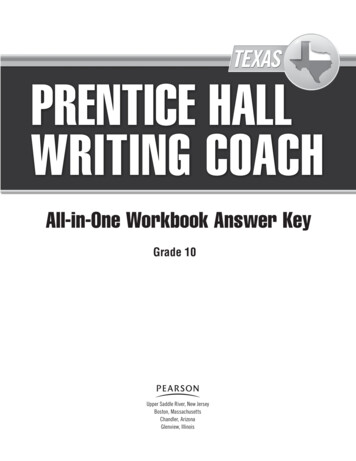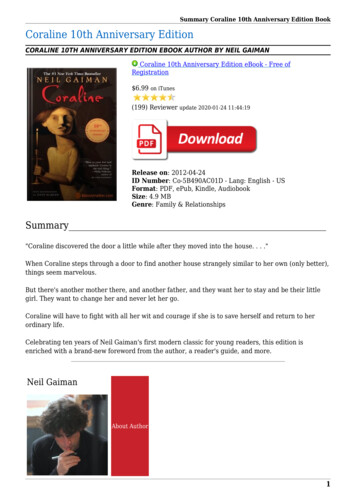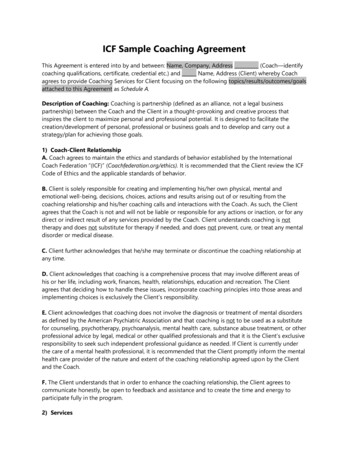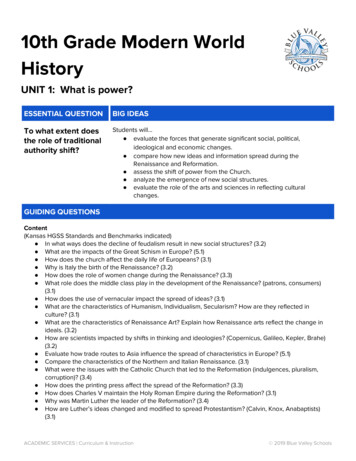
Transcription
Prentice HallWRITING COACHAll-in-One Workbook Answer KeyGrade 10Upper Saddle River, New JerseyBoston, MassachusettsChandler, ArizonaGlenview, Illinois
Copyright by Pearson Education, Inc., or its affiliates. All Rights Reserved. Printed in theUnited States of America. This publication is protected by copyright, and permission shouldbe obtained from the publisher prior to any prohibited reproduction, storage in a retrievalsystem, or transmission in any form or by any means, electronic, mechanical, photocopying,recording, or likewise. The publisher hereby grants permission to reproduce these pages, inpart or in whole, for classroom use only, the number not to exceed the number of studentsin each class. Notice of copyright must appear on all copies. For information regarding permissions, write to Rights Management & Contracts, Pearson Education, Inc., One LakeStreet, Upper Saddle River, New Jersey 07458Pearson, Prentice Hall, and Pearson Prentice Hall are trademarks, in the U.S. and/or othercountries, of Pearson Education, Inc., or its affiliates.ISBN-13: 978-0-32-862491-1ISBN-10: 0-32-862491-82 3 4 5 6 7 8 9 10V00414 13 12 11
TEXAS PRACTICETEXAS PRACTICETEXAS PRACTICETEXAS PRACTICEContentsPart 2: TEKS Practice Answers. TX 1Part 3: Practice Test Answers. TX 8Part 4: Grammar Practice Answers. 1Part 5: Vocabulary and Spelling Practice Answers. 54Part 6: Academic and Workplace Skills Activities Answers. 73Copyright Pearson Education, Inc., or its affiliates. All rights reserved.CA iiiTX iiiTEXAS P
OH PRACTICEPRACTICE TEXASOH PRACTICEACTICETEXAS ICE OH TEXASPWriting Coach All-in-One Workbook AnswersPart 2: TEKS Practice AnswersTX 3TEKS 11. C2. J3. B4. H5. CTX 5TEKS 21. D2. H3. A4. F5. – 6. Guide students in locating appropriate texts for each activity. Answers willvary. Students’ responses should show an understanding and mastery of theskills that make up the standard. Possible responses: 5. Whitman’s elegy forAbraham Lincoln, “O Captain! My Captain!” uses the extended metaphor ofa dangerous sea voyage. That metaphor was prompted by the perils of theAmerican Civil War. 6. Homer’s epic poem the Odyssey and Robert Frost’slyric poem “Home Burial” both explore the importance of home.TX 7TEKS 31. C2. F3. Possible answer: Bradstreet is saying that she loves her husband intensely, morethan she loves anything else, and that she treasures his love for her.4. Possible answer: Bradstreet uses an aabbccddeeff rhyme scheme, with only asingle stanza. The meter of the poem is iambic pentameter, meaning there arefive feet per line, each consisting of an unstressed followed by a stressed syllable.Some students may perceive there are slight variations in this pattern; forexample, an anapest (unstressed, unstressed, stressed) in the second foot of line10 and extra unstressed syllables at the end of lines 11 and 12.5. Answers will vary, possible answer: By declaring she values her husband’s lovemore than “whole mines of gold” she establishes that nothing is greater thanthis love. Her imagery creates an impression of her love as a fire or thirst that noamount of water can “quench.” Her repeated use of the word “love” in differentcontexts constantly returns the reader to her central message, which is thestrength of her love.Copyright Pearson Education, Inc., or its affiliates. All rights reserved.TX
TEXAS PRACTICETEXAS PRACTICETEXAS PRACTICETEXAS PRACTICETX 9TEKS 41. A2. H3. Answers will vary.4. The motif is the repeated appearance of a ghost or ghosts in the play,foreshadowing tragedy. Here, the ghost hints that he will bring about Brutus’death in the coming battle.TX 11TEKS 51. B2. H3. BTX 13TEKS 61. D2. H3. J4. BTX 15TEKS 71. C2. F3. D4. G5. B6. Answers will vary. Possible answers: Imagery: “an orchard of starved apple‑treeswrithing over a hillside.” Symbolism: The farmhouse might be a symbol ofloneliness.TX 17TEKS 81. C2. J3. D4. F5. DCopyright Pearson Education, Inc., or its affiliates. All rights reserved.TX TEXAS P
TEXAS PRACTICETEXAS PRACTICETEXAS PRACTICETEXAS PRACTICETX 19TEKS 91. Answers will vary. Students may conclude that the successful marketingstrategy Morrisey mentions in the first article might be related to the informationDataSourcez claims was stolen. Students might call into question Morrisey’sintegrity and honesty.2. Possible answer: Article 2 uses anecdotal evidence to support the conclusion thatTeenLife may have to pay money to DataSourcez. However, empirical evidenceindicates that the stock fell 20% in the third quarter and that construction hasbeen halted on three new stores in Oklahoma.3. Possible answer: It appears that TeenLife, Inc., is in fairly serious financialtrouble, with investors worried about the corporate scandal. Falling stock priceshave made it impossible for the company to continue building stores outsideTexas. Knowing how a settlement between TeenLife, Inc. and DataSourcez mightaffect TeenLife, Inc.’s stock might allow one to interpret the situation moreaccurately.TX 21TEKS 101. B2. G3. D4. Answers will vary. Students’ responses should show an understanding andmastery of the skills that make up the standard. Possible response: As everyoneagrees, juniors like Matt don’t have time for extra-curricular activities becausethey’re too busy thinking about college (appeal to commonly held opinions);You must either elect Sasha or watch as our school government collapses (falsedilemma); for years, Sasha has been waiting for this chance to serve her fellowstudents (appeal to pity); I don’t want to spread rumors, but Matt was reportedlyseen stealing quarters from a school vending machine (personal attack).TX 23TEKS 111. C2. G3. The pyramid represents the estimated populations of male and femaleAmericans within given age groups in the year 2025.4. There will be more 30- to 35-year-olds than 45- to 49-year-olds in 2025. This holdstrue for both males and females. The estimate for the younger group is about12 million males and 12 million females. The estimate for the older group isabout 11 million males and 11 million females.5. Answers will vary. Possible response: Students might expect to find thispopulation pyramid in an article about U.S. population growth that appears in agovernment journal, a newspaper, or a magazine.Copyright Pearson Education, Inc., or its affiliates. All rights reserved.TX TEXAS P
TEXAS PRACTICETEXAS PRACTICETEXAS PRACTICETEXAS PRACTICETX 25TEKS 121. D2. G3. D4. F5. – 6. Answers will vary. Students’ responses should show an understanding andmastery of the skills that make up the standard. Possible responses: 5. Studentsmay note the way in which many news shows today combine informationwith entertainment. They may observe how shifts between these two purposesaffect the tone and level of formality. 6. Students may refer to the commercials’quick visual set up of mini-dramas involving families and friends. They mayalso refer to the use of music to enhance a mood or create excitement.TX 27TEKS 131. A2. F3. C4. Answers will vary. Students’ outlines should organize ideas in a logical order.You might offer students several possibilities, including beginning with the leastimportant reason and proceeding to the most important.5. Answers will vary. Students’ compositions should include a thesis andsupporting details presented in a logical order. Students should complete fillingin the rubric and discuss the results with their partner.TX 29TEKS 14Answers will vary. Students’ responses should demonstrate an understandingand mastery of the skills that make up the standard. Pacing might be a difficultconcept for some students. Explain to them that pacing refers to the ways in whicha writer can slow readers down or speed them up at critical points and throughoutthe story. For example, by zooming in on a particular moment, a writer can slowthe pace and create tension. To help students visualize the concept, have themconsider pacing in a film: how the director can make events seem to speed up orslow down through editing and the use of different camera angles.TX 31TEKS 151. B2. H3. C4.–6. Answers will vary. Students’ responses should demonstrate anunderstanding and mastery of the skills that make up the standard. Helpstudents distinguish between an opening statement, which is meant tocapture readers’ attention and orient them to the topic, and a thesis, whichstates the controlling idea of the composition.Copyright Pearson Education, Inc., or its affiliates. All rights reserved.TX TEXAS P
TEXAS PRACTICETEXAS PRACTICETEXAS PRACTICETEXAS PRACTICETX 33TEKS 16Answers will vary. Students’ responses should demonstrate an understandingand mastery of the skills that make up the standard. Encourage students toconsider whether the statistic would be more impressive if more informationabout the study were provided, such as the researchers’ names, the journalwhere it was published, and the date it was published.TX 35TEKS 171. B2. H3. B4. F5.–8. Answers will vary. Students’ responses should demonstrate an understandingand mastery of the skills that make up the standard. Possible responses: 5. Ilearned generosity from Mike, and I also learned bravery. 6. When I am fiveyears older, I would like to become a firefighter. 7. I prefer that he removehis winter coat before we start playing. 8. People who do not like pizza arenot worth knowing (restrictive clause). I’m certain that we would not getalong with each other anyway (reciprocal pronouns). They don’t even like todiscuss pizza toppings, and they feel justified in their prejudice (compoundsentence, joined by conjunction). I, on the other hand, wish I were eating apizza with extra cheese right now (subjunctive mood).TX 37TEKS 181. C2. G3. C4. J5. The most terrifying moment of my life came quite suddenly, when Mr. Fisherannounced that we would begin swimming lessons. I was eight, just old enoughto go to summer camp for the first time. I had looked forward to a week at CampWildwood, but little did I know what awaited me.TX 39TEKS 191. A2. H3. D4. G5. sophomoric6. chatting7. archival8. performance9. annuallyCopyright Pearson Education, Inc., or its affiliates. All rights reserved.TX TEXAS P
TEXAS PRACTICETEXAS PRACTICETEXAS PRACTICETEXAS PRACTICETX 41TEKS 201. C2. F3. B4. G5. D6. Responses will vary. Students should be able to write three focus questions andformulate a research plan based on those questions. Encourage students to selecta variety of sources to help them answer their focus questions.TX 43TEKS 211. C2. J3. A4. H5. B6. Answers will vary. Possible response:BibliographyJenkins, Dru. Growing Up in Virginia. Chicago: Homestead Books, 2001.Stanton, William. “Plantation Life,” Americana Nov. 1998, 41–46. World Book, 14th ed.,s.v. “Colonial America.” www.correctURL .TX 45TEKS 221. D2. F3. B4. Answers will vary. Possible responses: the Internet, newspaper articles,encyclopedias, news broadcasts, town records. Students should have logicalreasons for their choices.5. Answers will vary. Students may suggest looking in news articles, interviewswith players, almanacs that list specific incomes of professional sports players,editorials, and biographies. Many of the sources will likely include both factsand opinions, although the almanac would focus on facts and statistics.TX 47TEKS 23Answers will vary. Students’ responses should show an understanding andmastery of the skills that make up the standard. If students are looking forrelevant secondary sources, explain that the introductions to individual playsin editions of Shakespeare’s works often comment on the political backgroundof the play. You might also suggest that students consult biographies ofShakespeare and Queen Elizabeth I.Copyright Pearson Education, Inc., or its affiliates. All rights reserved.TX TEXAS P
TEXAS PRACTICETEXAS PRACTICETEXAS PRACTICETEXAS PRACTICETX 49TEKS 241. C2. F3. C4. G5. DTX 51TEKS 25Responses will vary. Students’ responses should show an understanding andmastery of the skills that make up the standard. When students research thesubject of the speech, assure them that they will find materials on the Internetif they search on “money management courses for high school students”or a similar phrase. As they evaluate their speech, be sure they consider thevarious aspects of the delivery, including eye contact, speaking rate, volume,pronunciation, gestures, and language conventions.TX 53TEKS 261. D2. H3. A4. J5. B6. Answers will vary. Students’ responses should show an understanding andmastery of the skills that make up the standard.TX 55TEKS RC-(10)(A), (B)1. Possible answer: After hosting many guests throughout the winter, Mrs. Barodawas surprised and somewhat miffed to learn that her husband’s friendGouvernail would be visiting for a week or two. After Gouvernail arrived,however, Mrs. Baroda found him inexplicably likable, although he differedconsiderably from her expectations.2. Answers will vary. Students should list three questions they asked whilereading the excerpt and discuss how questioning the text affected theircomprehension of it.3. Answers will vary. Students may say they visualized how Mrs. Baroda picturedGouvernail and then what Gouvernail actually looked like.4. Answers will vary. Students may infer that, based on how Mrs. Baroda judgesGouvernail, she judges people before she meets them. They may also infer thatMrs. Baroda is wealthy based on the fact that she entertains often and mentionsthat Gouvernail is not a “society man.”Copyright Pearson Education, Inc., or its affiliates. All rights reserved.TX TEXAS P
TEXAS PRACTICETEXAS PRACTICETEXAS PRACTICETEXAS PRACTICEPart 3: Practice Test AnswersPractice Test 1Reading TestTX 56–TX 851. B2. H3. A4. F5. D6. G7. C8. Answers will vary, but should include the following details: (1) through onlineresearch, Erica and Carl learned that crows identify and remember people’sfaces; (2) Erica and Carl wore Amelia Earhart and Abe Lincoln masks to scarethe crows in their nests; (3) Erica then placed the two masks on scarecrows in thegarden; and (4) the crows stayed out of the garden.9. B10. H11. A12. J13. B14. H15. C16. G17. A18. C19. G20. D21. G22. D23. H24. C25. C26. F27. D28. G29. C30. J31. B32. Answers will vary but should include the following details: (1) The gray wolfpreys on animals that humans have hunting seasons for, so humans will wantto be sure that wolves do not reduce those populations too much; (2) the graywolf may still attack domestic livestock, which causes losses for farmers andCopyright Pearson Education, Inc., or its affiliates. All rights reserved.TX TEXAS P
TEXAS PRACTICETEXAS PRACTICETEXAS PRACTICETEXAS PRACTICEranchers; and (3) both of these areas of concern require monitoring to make surethe interactions and the populations stay in balance. Answers should includethe following elements: (1) ideas organized into a clear introduction, body, andconclusion; (2) smooth transitions that provide a logical progression of ideas;(3) a variety of correct sentence structures; and (4) no errors in capitalization,punctuation, spelling, or grammar.33. A34. H35. D36. F37. A38. G39. A40. H41. A42. H43. B44. F45. D46. G47. Answers will vary, but should include the following details: (1) In Why Are YouHere?, the author has a positive view of advances in medicine. New medicines,such as vaccines and antibiotics, and advances in hygiene, such as clean waterand improved safety, have helped to save many lives since the beginning ofthe twentieth century; and (2) In Danger Lurks, the author shows concern aboutmodern medicine and current habits. Modern medicines have resulted in drugresistant “superbugs” that have evolved because of antibiotics. The author showsconcern for the spread of infections due to increased travel. Answers shouldinclude the following elements: (1) ideas organized into a clear introduction,body, and conclusion; (2) smooth transitions that provide a logical progressionof ideas; (3) a variety of correct sentence structures; and (4) no errors incapitalization, punctuation, spelling, or grammar.Practice Test 2English and Reading TestTX 87– TX 107English Test1. D2.3.4.5.6.7.FBHCJBCopyright Pearson Education, Inc., or its affiliates. All rights reserved.TX TEXAS P
TEXAS 9.40.41.42.43.44.45.46.47.TEXAS PRACTICETEXAS pyright Pearson Education, Inc., or its affiliates. All rights reserved.TX 10TEXAS PRACTICETEXAS P
TEXAS 62.63.64.65.66.67.68.69.70.71.72.73.74.75.TEXAS PRACTICETEXAS PRACTICEGDJBJDHAGAFCHBJAGDGDFCJBHDHAReading Test1. C2. F3. D4. H5. A6. G7. B8. J9. D10. FCopyright Pearson Education, Inc., or its affiliates. All rights reserved.TX 11TEXAS PRACTICETEXAS P
OH PRACTICEPRACTICE TEXASOH PRACTICEACTICETEXAS ICE OH TEXASPPart 4: Grammar Practice AnswersChapter 13Nouns (1)4.5.6.7.8.9.10.Practice A Identifying Nouns1.2.3.4.5.6.7.8.9.10.keys, counterdog, parkcat, chairdoctor, appointmentweather, Australia, Januarystudent, award, attendancegroup, flowers, Prospect Parkbasketball, speed, staminateam, beach, California friendship, Samantha, Kyle,kindergartenPractice B Identifying Reciprocal,Reflexive, and Intensive Pronouns1.2.3.4.5.6.Practice B Labeling Nouns1. success—common, abstract2. Uncle Chris—proper, concrete;museum—common, concrete3. chores—common, concrete4. sister—common, concrete;Boston—proper, concrete5. kitten—common, concrete;love—common, abstract6. computer—common, concrete;movie—common, concrete7. wish—common, abstract;loyalty—common, abstract8. To Kill a Mockingbird—proper, concrete;Harper Lee—proper, concrete9. excitement—common, abstract;afternoon—common, abstract10. mountain—common, concrete; PikesPeak—proper, concreteChapter lexiveeach other—reciprocalhimself—intensiveone another—reciprocalhimself—reflexiveeach other—reciprocalChapter 13 Action Verbs andLinking Verbs (3)Practice A Identifying Action Verbs1.2.3.4.5.workscriesateownsridesPractice B1.2.3.4.5.Identifying Linking VerbsissoundsbecamefeltwasPractice C Distinguishing BetweenAction Verbs and Linking VerbsPronouns (2)Practice A Identifying Pronouns andAntecedents1.2.3.4.5.1. Terrence2. Mrs. Stream3. Alexandriafelt—linking verbwon—action verbwas—linking verbis—linking verbcelebrated—action verbAll-in-One WorkbookCopyright Pearson Education, Inc., or its affiliates. All rights reserved.
TEXAS PRACTICETEXAS PRACTICETEXAS PRACTICETEXAS PRACTICEChapter 13 Transitive andIntransitive Verbs (4)Practice B Identifying Helping Verbsand Main VerbsPractice A Identifying TransitiveVerbs and Their ObjectsStudents will underline the helping verband circle the main verb.1. is—raining2. should be—leaving3. are—changing4. does—want5. might—learn6. is—reading7. have—seen8. is—planning9. was—helping10. has—wonStudents will underline the first term andcircle the second.1. wrote—e-mail2. takes—bus3. explained—assignment4. brought—jacket5. updated—status6. won—prize7. needs—insulation8. offers—route9. drives—carChapter 1310. make—rulesPractice A Identifying AdjectivesPractice B Distinguishing BetweenTransitive and Intransitive tivedocks—transitivecried—intransitiveChapter 13Thatrapa, brand-nameSome, Persian, beautifulgreen, theThat, spottedtunaThe, old, broken, uselessAbstractfavoritePractice B Identifying Nouns Usedas AdjectivesVerb Phrases (5)1.2.3.4.5.6.7.8.9.10.Practice A Recognizing Verb Phrases1.2.3.4.5.6.7.8.9.10.Adjectives (6)should have comeis watchinghas been thinkinghad been livingdoes holdhave seenwill be gettingis usingmight be comingis adocheesemachinebudgetAll-in-One WorkbookCopyright Pearson Education, Inc., or its affiliates. All rights reserved. TEXAS P
TEXAS PRACTICETEXAS PRACTICEChapter 13TEXAS PRACTICEAdverbs (7)9. without his briefcase10. on the porchPractice A Recognizing Adverbs1.2.3.4.5.6.7.8.9.10.Practice B Identifying Prepositionsand Their ightlyrarelyyesterdayhardStudents will underline the first term andcircle the second.1. at—noon2. with—parents3. in—ocean4. to—Europe5. to—Houston; on—bus6. for—years7. of—doctor8. to—school9. with—dip10. for—couchPractice B Identifying Adverbs andthe Words They Chapter 13Conjunctions (9)Practice A Identifying Conjunctions1.2.3.4.5.6.7.8.9.10.Chapter 13 Prepositions andPrepositional Phrases (8)Practice A Identifying Prepositionsand Prepositional Phrases1.2.3.4.5.6.7.8.TEXAS PRACTICEbutEither orandorafterwhennot only but alsoeither orin order towhenPractice B Identifying Types ofConjunctionsin the cabinetof the bookat sunrisein the grassin the basketin Thailandunder rocksaround the ngwhile—subordinatingbut—coordinatingeither or—correlativeafter—subordinatingAll-in-One WorkbookCopyright Pearson Education, Inc., or its affiliates. All rights reserved. TEXAS P
TEXAS PRACTICETEXAS PRACTICETEXAS PRACTICE7. before—subordinating8. neither nor—correlativeChapter 137.8.9.10.Interjections (10)Practice A Identifying Interjections1.2.3.4.5.6.7.8.9.10.TEXAS PRACTICEHey!OK!Wow!Hey!Chapter 13 Identifying Parts ofSpeech hWowYuckWhat?Practice A Identifying Parts ofSpeech: Nouns, Pronouns, Verbs,Adjectives, and actice B Identifying Parts ofSpeech: Prepositions, Conjunctions,and InterjectionsPractice B Supplying InterjectionsAnswers may vary. Sample answers aregiven.1. Shhh!2. Uh-oh!3. Oops!4. Hey,5. So long!6. onjunctionconjunctionAll-in-One WorkbookCopyright Pearson Education, Inc., or its affiliates. All rights reserved. TEXAS P
OH PRACTICEPRACTICE TEXASOH PRACTICEACTICETEXAS PRACTICETEXASOHPRACTICEChapter 14 Simple Subjects andPredicates (12)9. sentence10. sentencePractice A Identifying SimpleSubjectsPractice B1.2.3.4.5.6.7.8.9.10.will opedhidesChapter 14Chapter 14 Subjects inDeclarative Sentences BeginningWith Here or There (14)Practice A Rearranging SentencesBeginning With Here or TherePeople are in the house.Oil is in the pan.The money from the bake sale is here.Three people are walking.A quarter is in the machine.Your games are here.The shovel for your garden workis here.8. Apples are in the basket.9. A blanket is in the closet.10. An empty box is here.1.2.3.4.5.6.7.Fragments (13)Practice A Distinguishing Sentencesand Fragments1.2.3.4.5.6.7.8.Fixing FragmentsAnswers may vary, but each sentenceshould include the fragment, as givenbelow.1. the tiny fish2. went flying through the air3. the colorful sunset4. hopped up on the table5. searching through the house6. the brand new toy7. his favorite food8. the quickest runner9. the article about her school band10. the next erpeoplePractice B Identifying CTICTEXASPRACTICE OH mentsentencefragmentPractice B Identifying Subjects andVerbs in Sentences Beginning WithHere or ThereStudents will underline the first term belowand circle the second.1. student—isAll-in-One WorkbookCopyright Pearson Education, Inc., or its affiliates. All rights reserved.
TEXAS PRACTICE2.3.4.5.6.7.8.9.10.TEXAS PRACTICETEXAS PRACTICEChapter 14 Subjects inImperative Sentences es—arelaundry—isPractice A Rewriting ImperativeSentences to Include You1. Tonight, you finish your homework.2. You enjoy the dessert next.3. You, by tonight, put away yourclothes.4. You, cook the meal when you returnhome.5. You, wash the dog.6. You, fill in the bubble with a pencil.7. You, please wash the dishes.8. You, go find the keys.9. You, bring some snacks to the party.10. You, call me after work.Chapter 14 Subjects inInterrogative Sentences (15)Practice A Rearranging InterrogativeSentences1.2.3.4.5.6.7.8.9.10.TEXAS PRACTICEYou are doing what?The conference is where?You are over your cold?The answer to number four is what?They are expecting you to bring adessert?The stars are so bright on cold nightswhy?You are going to the party tomorrow?I should pick you up when?You talked him into helping you how?You are in such a hurry why?Practice B Writing ImperativeSentencesAnswers may vary. Each answer should bean imperative sentence.Chapter 14 Subjects inExclamatory Sentences (17)Practice A Identifying Subjects inExclamatory Sentences1.2.3.4.5.6.7.8.9.10.Practice B Identifying Subjects andVerbs in Interrogative SentencesStudents will circle the first term andunderline the second.1. dad—did take2. I—can help3. you—do leave4. you—do(n’t) like5. friend—is meeting6. you—are shopping7. you—are daydreaming8. brother—is coming9. father—does make10. you—are doingyouYouIThisyouheYouIyoucarPractice B Writing ExclamatorySentences and Identifying SubjectsAnswers may vary. Each answer should bean exclamatory sentence. Each sentenceAll-in-One WorkbookCopyright Pearson Education, Inc., or its affiliates. All rights reserved. TEXAS P
TEXAS PRACTICETEXAS PRACTICETEXAS PRACTICEPractice B Identifying SentencesWith Indirect Objectsshould have the subject underlined. If thesubject you is implied, it should be written inparentheses next to the sentence.Chapter 141.2.3.4.5.6.7.8.Direct Objects (18)Practice A Identifying Direct olsstoriestimepackagefeetpianoPractice A Identifying oNoChapter 14YesYesYesNoNoYesYesNoChapter 14 Object Complements (20)Practice B Identifying Sentences WithDirect Objects1.2.3.4.5.6.TEXAS worsesuccessridiculousbreakthroughPractice B Completing SentencesWith Object ComplementsIndirect Objects (19)Practice A Identifying IndirectObjectsAnswers may vary. Sample answers aregiven.1. They appointed the man chair.2. The jury judged the man innocent.3. Sherry thought the idea brilliant.4. The class elected Antonio president.5. Joel named the kitten Homer.6. My mother called my room radioactive.7. The teacher declared my papersuccessful.8. Luis thought the weather horrible.9. They found the hotel convenient.10. Aunt Delia called my home cozy.Students will underline the first term andcircle the second.1. playhouse—son2. lunch—sister3. cake—husband4. question—mom5. gift—son6. picture—class7. sculpture—sister8. egg—brother9. gift—teacher10. grade—meAll-in-One WorkbookCopyright Pearson Education, Inc., or its affiliates. All rights reserved. TEXAS P
TEXAS PRACTICETEXAS PRACTICEChapter 14(21)TEXAS PRACTICESubject ComplementsPractice B Identifying PredicateNominatives and Predicate Adjectives1.2.3.4.5.6.7.8.9.10.Practice A Identifying SubjectComplements1.2.3.4.5.6.7.8.9.10.TEXAS PRACTICEkindgrandfatherpresidenticy, ragingred, goldfriend—predicate nominativedark, lovely—predicate adjectivesmarvelous—predicate adjectivetroublemaker—predicate nominativechampion—predicate nominativefresh—predicate adjectivehopeful—predicate adjectivehappy—predicate adjectiveteacher—predicate nominativehybrid—predicate nominativeAll-in-One WorkbookCopyright Pearson Education, Inc., or its affiliates. All rights reserved. TEXAS P
OH PRACTICEPRACTICE TEXASOH PRACTICEACTICETEXAS ICE OH TEXASPChapter 15 PrepositionalPhrases (22)9. Maria10. SydneyPractice A Identifying PrepositionalPhrasesPractice B Combining Sentences,Using Appositives1.2.3.4.5.6.7.8.9.10.into the holein the rainduring the movieunder the treefor collegeto his friendat the parkfor a tripin her reclinerwith the red berriesAnswers may vary. All answers shouldinclude a correctly placed appositive.1. Susan, a college student, studies often.2. I attend a great high school, Harrison.3. Sonya, a professional singer, travelsthe world.4. Jorge, my best friend, enjoys sports.5. Kathy, my favorite cousin, is coming tovisit this weekend.Chapter 15Practice B Identifying Adjectivaland Adverbial Phrases1.2.3.4.5.Practice A Identifying Verbals andVerbal PhrasesAdjectival phraseAdverbial phraseAdverbial phraseAdjectival phraseAdjectival phrase1.2.3.4.5.6.7.8.9.10.Chapter 15 Appositives andAppositive Phrases (23)Practice A Identifying Appositives1.2.3.4.5.6.7.8.Verbal Phrases (24)the girl who loves readingmy sisterJonahMrs. Willisthe one my father gave meUncle Fred’s favorite pastimea huge flockJohn and Stephanieexhausted from fatiguepicked off the treelimping badlysleepingnewly mintedfreshly mowedfallingHoping to be on timegrounded for two dayssmelling treatsPractice BPhrases1.2.3.4.5.Recognizing Verbalparticipial phraseparticipial phraseverbparticipial phraseparticipial phraseAll-in-One WorkbookCopyright Pearson Education, Inc., or its affiliates. All rights reserved.
TEXAS PRACTICETEXAS PRACTICET
TEXAS PRACTICE TEXAS PRACTICE TEXAS PRACTICE TEXAS PRACTICE TEXAS PR TX 25 TEKS 12 1. D 2. G 3. D 4. F 5. – 6. Answers will vary. Students’ responses should show an understanding and mastery of the skills that make up the standard. Possible responses: 5. Students may note the way in










